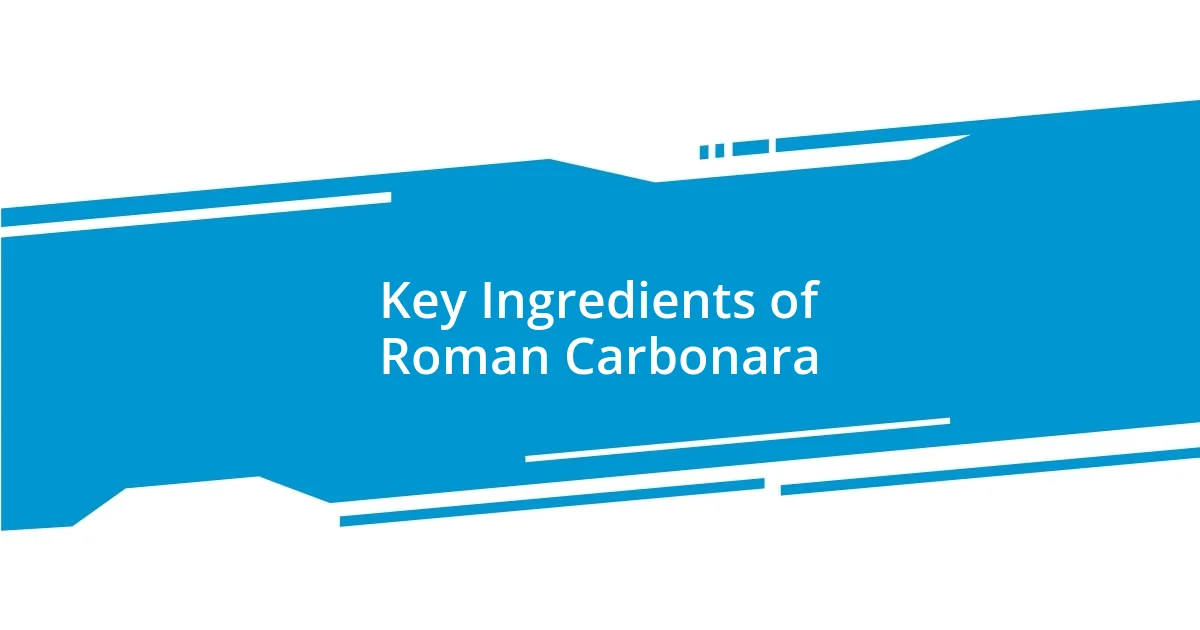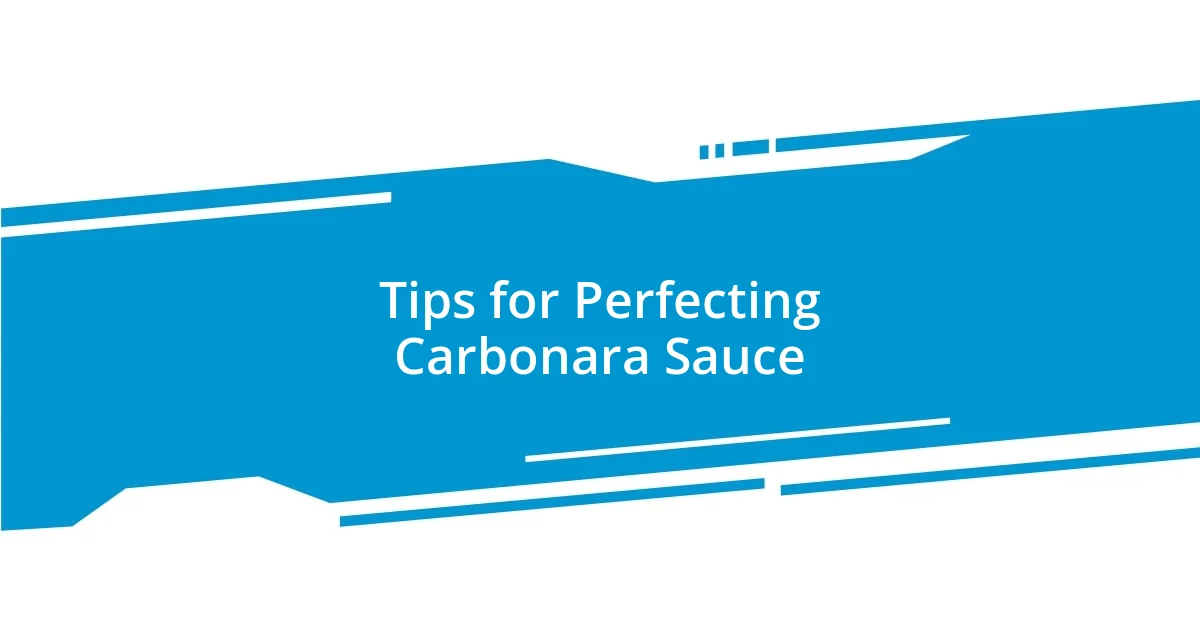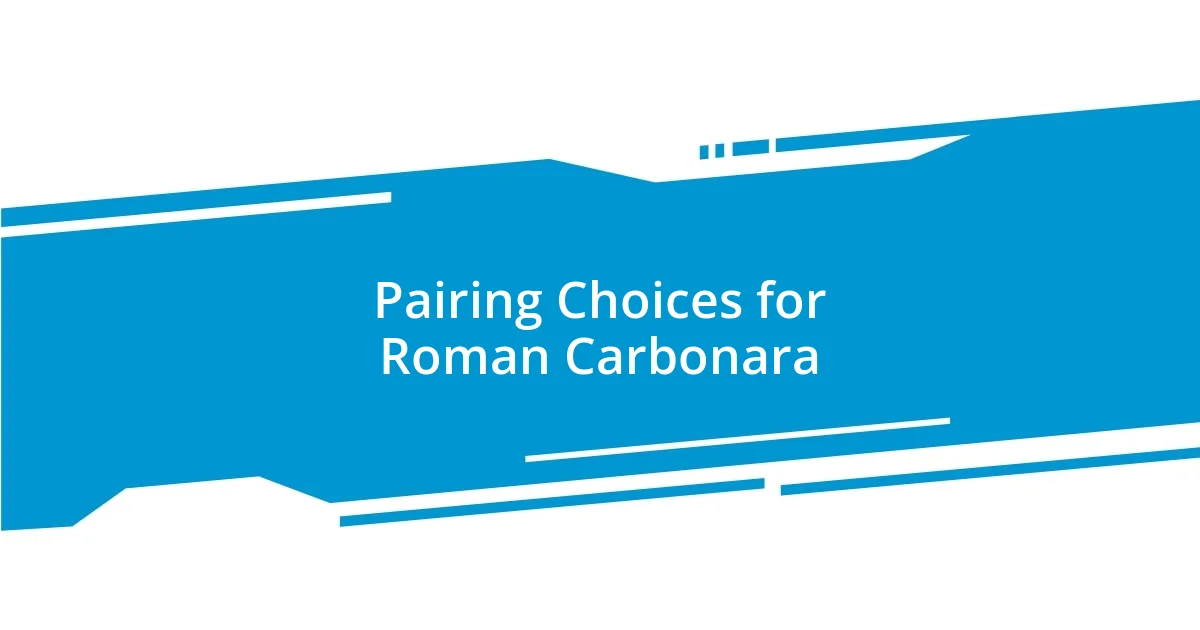Key takeaways:
- Roman Carbonara is a simple yet flavorful dish made with quality ingredients: pasta, guanciale, pecorino Romano, eggs, and black pepper.
- The traditional preparation method emphasizes timing and technique to achieve a creamy sauce without scrambling the eggs.
- Common mistakes to avoid include using incorrect cheese, adding cream, and overcooking the pasta, all of which can detract from the authentic experience.

Introduction to Roman Carbonara
When I first tasted Roman Carbonara, it felt like a culinary revelation. The creamy sauce, made with eggs and pecorino Romano cheese, envelops perfectly al dente pasta, creating a delightful harmony of flavors. Have you ever experienced a dish that made your heart sing? That’s exactly what happened to me.
The beauty of Roman Carbonara lies in its simplicity. A few quality ingredients—guanciale, black pepper, and that luscious cheese—come together to create something truly magnificent. My family often shares stories of our trips to Rome, where we would dive into a plate of Carbonara at a bustling trattoria, savoring each bite as if it were a treasured memory. Isn’t it interesting how food can transport us back to such special moments?
Each forkful of Carbonara offers a taste of Roman tradition, steeped in history yet vibrant in modern culture. I often find myself pondering why this dish has remained a favorite for so many, and I believe it’s the comforting familiarity that draws us in. There’s something about the rich flavors and creamy texture that feels like love on a plate, doesn’t it?

Key Ingredients of Roman Carbonara
The magic of Roman Carbonara stems from its few, but exceptional ingredients. Each element plays a vital role, creating that classic, creamy texture and unforgettable flavor. I remember my first attempt at making this dish at home; I carefully sourced authentic guanciale. The scent of that crispy pork, sizzling in the pan, instantly transported me to a quaint Roman kitchen.
Key ingredients of Roman Carbonara:
- Pasta: Traditionally, spaghetti or rigatoni.
- Guanciale: This cured pork cheek provides a unique savory richness.
- Pecorino Romano: A sharp, salty cheese that elevates the dish.
- Eggs: Used to create the creamy sauce, often just the yolks for added richness.
- Black Pepper: Freshly cracked for that perfect spice kick.
Each time I whip up a batch, I feel a sense of connection to Italy and its rich culinary heritage. I often recall a dinner with friends, laughing as we tried to master the delicate balance of cheese and pepper—it’s those moments that make the dish even more special.

Traditional Methods of Making Carbonara
When preparing traditional Roman Carbonara, the method is just as important as the ingredients. I remember watching a seasoned Italian chef expertly tossing the pasta with rendered guanciale, creating that irresistible aroma that filled the air. It’s a dance of timing—removing the pasta from the heat just before adding the egg and cheese mixture to ensure that it becomes creamy without scrambling. This careful attention to technique truly highlights the authenticity of the dish.
Another fascinating aspect is the simplicity of the cooking techniques involved. Often, I’ve seen home cooks mistakenly overcomplicate Carbonara, convinced it requires sophisticated culinary skills. However, the magic lies in mastering the basics: a hot pan, quality ingredients, and confident mixing. It’s reminiscent of those carefree cooking sessions with friends when laughter fills the kitchen and the focus shifts from perfection to pleasure—all we needed was pasta and a few good stories.
Finally, the choice of pasta plays a significant role in the traditional approach. While many enjoy variations with different shapes, I find there’s something undeniably comforting about twirling spaghetti around my fork, just as they do in Rome. Each twist brings back memories of bustling piazzas and vibrant conversations, serving as a delicious reminder that some recipes are best enjoyed as they were intended—simple, pure, and true to their roots.
| Traditional Method | Description |
|---|---|
| Preparation of Guanciale | Dice the guanciale and cook until crispy, allowing the fat to render out, which adds flavor to the dish. |
| Pasta Cooking | Cook spaghetti or rigatoni in salted water until al dente; this is crucial for the ideal texture. |
| Combining Ingredients | Toss the hot pasta with guanciale and fat, then mix in egg yolks and pecorino Romano swiftly to create a creamy sauce. |
| Final Touch | Finish with freshly cracked black pepper for seasoning, ensuring the dish stays traditional and vibrant. |

Tips for Perfecting Carbonara Sauce
When I set out to perfect my Carbonara sauce, the first tip I always keep in mind is the importance of temperature. Once, I was in a rush and added the egg mixture too soon, resulting in scrambled eggs instead of creamy goodness. It was a disappointing moment, teaching me that patience truly pays off—waiting until the pasta cools slightly before mixing in the eggs ensures that perfect creamy texture.
Another crucial element is the balance of cheese to egg. Initially, I found myself unsure about how much Pecorino Romano to use, fearing it might overshadow the dish. But, through trial and error—and a few too salty plates—I realized that a generous handful of cheese creates depth without overwhelming the flavors. Imagine the surprise as I took a bite of my perfected dish; the subtle tang of the cheese paired beautifully with the savory guanciale, singing a harmonious symphony of flavors.
Don’t overlook the power of freshly cracked black pepper, either. I recall a gathering where we all contributed our interpretations of Carbonara. A friend used pre-ground pepper, and while her dish was delicious, it fell flat compared to the vibrant warmth of freshly cracked pepper in mine. Not only does it elevate the flavor, but it also adds a lovely visual touch—the aromatic burst of this simple yet essential ingredient transforms the entire experience. What can I say? A little bit of thoughtfulness goes a long way in crafting that perfect Carbonara sauce.

Common Mistakes to Avoid
When making Carbonara, a common mistake is using the wrong kind of cheese. I’ve been in that situation too; once, I reached for a bag of pre-grated parmesan instead of pecorino Romano. Let me tell you, the taste was just not the same. The sharp, salty notes of pecorino are crucial, and it really ties the dish together. Isn’t it fascinating how a single ingredient can make or break a traditional recipe?
Another pitfall I often see is adding cream to the sauce. I remember a dinner party where a guest insisted on including cream for extra richness. While I appreciated the attempt at indulgence, the result strayed far from authentic Carbonara. The creaminess from the eggs and cheese should shine through without being masked. Have you ever had a dish that just didn’t sit right? That’s how I felt in that moment—it’s important to let the simplicity of the recipe stand on its own.
Finally, watch the timing of your pasta. I once pulled the spaghetti from the pot a little too late, and it turned mushy—definitely not the texture you want! It’s essential to cook it al dente. This isn’t just about taste; it’s about the overall experience of twirling that pasta around your fork. So next time, trust your instincts and keep an eye on the clock—your taste buds will thank you!

Pairing Choices for Roman Carbonara
Pairing drinks with Roman Carbonara is an art in itself. Personally, I’ve found that a crisp, dry white wine, like a Frascati or a Verdicchio, complements the dish beautifully. The acidity cuts through the richness of the guanciale and cheese, creating a refreshing contrast that leaves your palate wanting more. Have you ever experienced that perfect sip that elevates a meal? That’s what a good pairing can do.
If you’re leaning towards something non-alcoholic, consider pairing your Carbonara with sparkling water infused with lemon or herbs. This not only refreshes but also balances the savory elements in the dish. I once hosted a dinner where the guests were impressed by how a simple beverage could enhance flavors so effectively. It’s amazing how thoughtful pairing choices can transform a meal into a memorable experience.
For those special occasions, an aperitif like a Negroni could be a delightful start before diving into your Carbonara. The bold bitterness complements the dish in a way that sparks your appetite. I’ll never forget the evening I introduced this combination to a gathering of friends; the conversations flowed as easily as the drinks, and it made for an unforgettable night centered around good food and laughter. Try it—you might just find a new favorite!
















